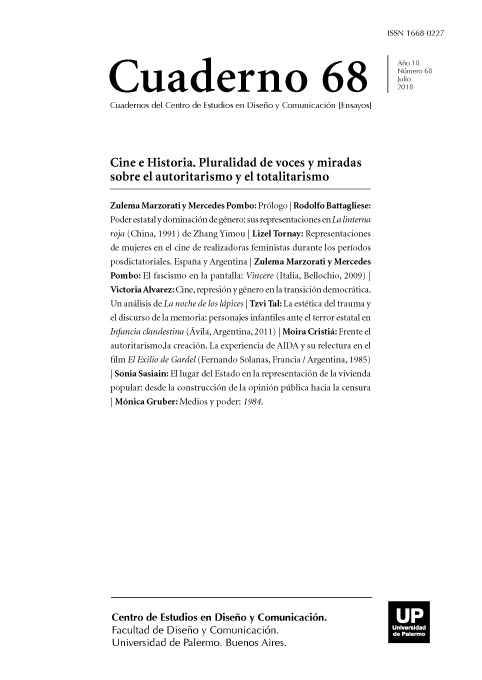Medios y poder: 1984
Abstract
World War II, the Shoah, the Gulag, Hiroshima and Nagasaki, constitute a long list of ignominious facts that have set fire to humanity. Not surprisingly, lucid intellectuals and artists raised their voices to point out the failure of the ancient rational paradigms that underpinned modernism: if that rationalism had led to failure, it was necessary to look for new structures that would help to overcome the past. Thus they saw a hope in the resurgence of the myth.
With the postwar period, a stage known as the Cold War was opened, which was characterized, among other things, by the dizzying growth of communication, as well as the development of all kinds of control mechanisms and gadgets ranging from microfilms and microphones, to cameras. The USSR and the US, with their secret services, played a war of nerves where everything seemed valid: serum of truth, various tortures and brainwashing, among others, were terms that moved from the political field to literature, cinema and theater. These elements contributed to the imagination of the artists, who in cases such as the one we analyzed, placed criticism on the world around them in a dystopian future.
The present work aims to analyze some aspects of George Orwell ‘s novel 1984 (1948), exploring the lines of hermeneutic depth that gave life to its characters and conflicts, and then to approach the homonymous cinematographic transposition.
In comparing the relationship between the media and power –a fundamental aspect both in the literary text and its impact on the audiovisual– we maintain that just as the life of the citizens in the novel is totally controlled by the agents of power, this is again evident in the film of the same name filmed in 1984, a situation that also extends today. Much to our regret, totalitarianisms continue to prevail today.
References
Adorno, T. W. (2005). Ensayo sobre la propaganda fascista. Psicoanálisis del antisemitismo. Buenos Aires: Paradiso.
Báez, F. (2005). Historia universal de la destrucción de los libros. De las tablillas sumerias a la guerra de Irak. Buenos Aires: Sudamericana.
Bauzá, H. F. (2005). Qué es un mito. Una aproximación a la mitología clásica. Buenos Aires: Fondo de Cultura Económica. Capanna, P. (2007). Ciencia Ficción. Utopía y mercado. Buenos Aires: Cántaro.
Di Tella, T.; Chumbita, H.; Gamba, S.; Gajardo, P. Diccionario de Ciencias Sociales y Políticas. Buenos Aires: EMECÉ.
Doob, L. W., “Goebbels y sus principios propagandísticos” en Moragas, M. (ed.) (1979). Sociología de la Comunicación de Masas. Barcelona: Gustavo Gili, pp. 381-404.
Foucault, M. (1993). Genealogía del racismo. Montevideo: Caronte Ensayos.
__________. (2004). Vigilar y castigar. Nacimiento de la prisión. Buenos Aires: Siglo Veintiuno Editores Argentina.
Fusi, J. P. (2004). El malestar de la modernidad. Cuatro estudios sobre historia y cultura. Madrid: Biblioteca Nueva.
Germani, G. (2003). Autoritarismo, fascismo y populismo nacional. Buenos Aires: Universidad Torcuato Di Tella.
Gruber, M., “La temperatura en la que arden las ideas” en Babino, M. E. (Comp.). (2011). La literatura en el teatro y el cine. Buenos Aires: Nobuko/ FADU, pp. 57-71.
Levi, P. (2011). Los hundidos y los salvados en La trilogía de Auschwitz. Madrid: El Aleph.
Manguel, A. (2007). La biblioteca de noche. Bogotá: Norma.
Orwell, G. (1950). Mil novecientos ochenta y cuatro. Versión Arturo Bray. Buenos Aires: Guillermo Kraft.
Semprún, J. (1995). La escritura o la vida. Barcelona: Tusquets.
Tafalla, M. (2003). Theodor W. Adorno. Una filosofía de la memoria. Barcelona: Herder.
Wolf, S. (2001). Cine / Literatura. Ritos de pasaje. Buenos Aires: Paidós.
Los autores/as que publiquen en esta revista ceden los derechos de autor y de publicación a "Cuadernos del Centro de Estudios de Diseño y Comunicación", Aceptando el registro de su trabajo bajo una licencia de atribución de Creative Commons, que permite a terceros utilizar lo publicado siempre que de el crédito pertinente a los autores y a esta revista.


